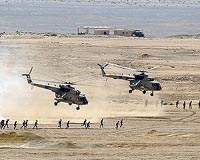| . |  |
. |
Canberra, Australia (UPI) Sep 17, 2010 Australia is set to be the first export country for Boeing's EA-18G Growler, which the U.S. government approved for full-rate production only last December. The decision was made by the U.S. Technology, Transfer, Security Assistance, Review Board, a brief report in the Australian newspaper said, quoting unnamed sources. The order for the advanced electronic attack aircraft was given the go-ahead in late August, The Australian said. The board's ruling to allow export of the highly sophisticated planes comes as Australia ramps up its air force's capability. The Growler is essentially a specialized version of the two-seat F/A-18E/F Super Hornet fitted with ITT ALQ-99 radar jamming pods and an interference cancellation system, Northrop Grumman ALQ-218(V)2 radio frequency receiver and Raytheon ALQ-227 communication countermeasures suite for electronic surveillance. Power is from twin General Electric F414-GE-400 turbofans giving a maximum speed of nearly twice the speed of sound, around 1,190 mph at 40,000 feet. Maximum ceiling is 50,000 feet with a range of 1,275 nautical miles. The armaments have been removed to accommodate electronic surveillance and jamming equipment. This includes removing the wingtip missile launcher rail for the AIM-9 Sidewinder, as mounted on the Super Hornet, and replacing them with AN/ALQ-218 detection pods. In February 2009, the Labor government, which was re-elected this month, requested that 12 F/A-18F Super Hornets -- half a $6 billion 24-plane order -- be wired for electronic attack capabilities while they are still on the production line. This allowed the Super Hornets to be upgraded to the U.S. Navy's Growler configuration at a later date. "Wiring 12 of the Super Hornets as Growlers will give us the opportunity to provide taxpayers with better value for money," Defense Minister Joel Fitzgibbon said at the time. "If finally pursued, the relatively small investment will significantly enhance the Super Hornet's capability by giving electronic attack capacity and, therefore, the ability to nullify the systems of opposing aircraft. "It will also provide the Super Hornets with counter-terrorism capability through the ability to shut down the ground-based communications and bomb triggering devices of terrorists," he added. The purchase of the Super Hornets is bridging a foreseeable gap in Australia's air defense capability, authorities have said. The planes are to cover the retirement of its aging fleet of F-111 strike aircraft in the near future until the F-35 Joint Strike Fighter is operational by 2018. The U.S. Navy's current advanced electronic attack platform, the twin-engine, mid-wing Northrop Grumman EA-6B Prowler, in service since 1971. The Prowler, with a maximum speed of 650 mph and four crew, is being phased out in favor of the Growler that has been operational since 2008.
Share This Article With Planet Earth
Related Links The Military Industrial Complex at SpaceWar.com Learn about the Superpowers of the 21st Century at SpaceWar.com
 India to buy more Mi-17 military helos
India to buy more Mi-17 military helosNew Delhi (UPI) Sep 16, 2010 India plans to buy another 59 Mi-17 military helicopters worth $1.9 billion from Russian arms exporter Rosoboronexport, the head of India's air force said. The purchase is in addition to the 80 Mi-17s ordered in 2008. The first Mi-17 aircraft will be delivered this year, Air Chief Marshal Pradeep Vasant Naik said in an extensive interview with India Strategic, an Internet defense news W ... read more |
|
| The content herein, unless otherwise known to be public domain, are Copyright 1995-2010 - SpaceDaily. AFP and UPI Wire Stories are copyright Agence France-Presse and United Press International. ESA Portal Reports are copyright European Space Agency. All NASA sourced material is public domain. Additional copyrights may apply in whole or part to other bona fide parties. Advertising does not imply endorsement,agreement or approval of any opinions, statements or information provided by SpaceDaily on any Web page published or hosted by SpaceDaily. Privacy Statement |